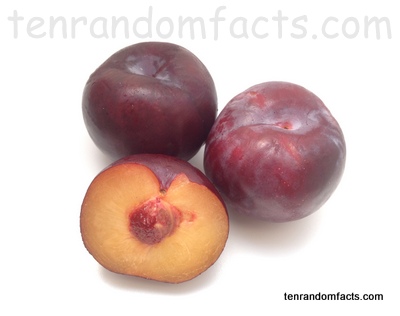How tiresome, the picking of plums must be.
- Plums are edible, fleshy fruit with a smooth skin, and contain a single pit or seed in the centre.
- Plums grow on trees that have the scientific genus name ‘Prunus’, that is from the family Rosaceae, the family of roses, and most commercially available fruit comes from the Japanese ‘Prunus salicina’ and the European ‘Prunus domestica’ species.
- The typical diameter of a plum reaches 3.5 to 7.6 centimetres (1 to 3 inches) and they are roughly spherical in shape.
- Plums are generally quite juicy, with flavours that vary from sweet to tart depending on the species and variety.
- Plums are commonly eaten raw, although they can be dried, juiced, pickled and cooked, the latter often in desserts; and the dried versions are known as ‘prunes’.
- The skin of plums can be coloured pink, yellow, red, purple, green or almost black, while the flesh can be white, yellow, red or green.
- The growing of plums for domestic purposes has been evident across Europe and Asia for approximately 2000 years.
- China produced approximately 6.1 million tonnes (6.7 million tons) in 2013, the most in the world, compared to the worldwide production of 11.5 million tonnes (12.6 million tons).
- Plums are high in vitamin C, and are good sources of vitamins A and K, as well as fibre.
- There are more than 2000 varieties of plums in the world, and they are usually individually picked at the best possible time, by hand.
Bibliography:
Plum, 2015, Wikipedia, http://en.wikipedia.org/wiki/Plum
Plums, 2011, Fresh for Kids, http://www.freshforkids.com.au/fruit_pages/plum/plum.html
Plums & Prunes, 2015, World’s Healthiest Foods, http://www.whfoods.com/genpage.php?tname=foodspice&dbid=35








